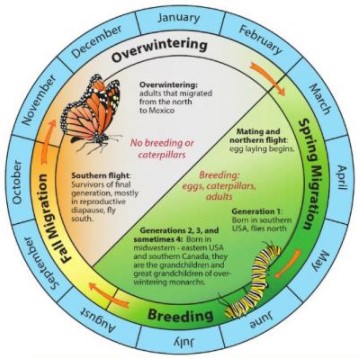By Erin Hodgson
Often people have fond memories of monarch butterflies and look forward to their arrival each summer. But there is some confusion about their migration pattern and population decline. “How can such a tiny butterfly travel such a great distance?” and “What do you mean the population is declining?” are common questions that are asked at educational events.
Monarch Migration. Monarchs undergo multigenerational migration (Fig. 1). In the spring, adult monarchs that spent the winter high in the mountains of Central Mexico fly north to Texas and Oklahoma where they lay eggs on milkweed plants (the only larval food plant). These eggs hatch and caterpillars eat milkweed leaves until they pupate into a chrysalis. The first generation adults emerge from the pupal case and these butterflies continue the journey north. Adults arrive in Iowa around May, with future generations traveling further north. After four generations produced over the entire summer, monarch adults get a cue that it is time to travel back to Mexico and escape the cold winter. Monarchs from all over the United States and Canada enter reproductive diapause (like hibernating for a bear) and catch a strong wind south. During the long flight, monarchs stop to feed on flowers to make sure they have enough fat stored to survive the winter.

Figure 1. Annual migration pattern of monarch butterflies. Note monarch caterpillars rely on milkweed for food from March through August.
Population Decline. Unfortunately, the monarch population has been in decline for the last 20 years, with historically low numbers occurring in the last five years. There are many reasons for the decline, but the most relevant to Iowa is the loss of caterpillar food (milkweed) in the Midwest because of land converted to agriculture.
What about the Monarchs Now? It is that time of the year when monarchs start the journey south to escape the upcoming cold months. On September 20, 2017, Royce Bitzer and I, both members of the ISU Monarch Workgroup, walked around natural areas in Ames, IA searching of monarch butterflies migrating south for the winter. It was quite a success! We counted 75 monarchs either flying south or feeding on floral nectar resources to sustain their long flight (Fig. 2). It is safe to say that the fall migration is in progress.
Figure 2. Monarch butterfly feeding on red clover, preparing for a long flight to Mexico.
Population Prediction. According to Chip Taylor in July 2017, it looks like a good year for monarch butterflies, with higher migration numbers and a larger overwintering population than the previous year. Taylor predicts that the overwintering population will use 4 or more hectares of overwintering habitat in comparison to 2.91 hectares used in 2016 (see his blog: Monarch Population Status). That is a big increase and great news for monarch enthusiasts!
Many of the research projects and monarch observations by the ISU Monarch Workgroup support Taylor’s prediction of an increase in overwintering population size. Specifically, I collect monarchs throughout the summer. The mitochondrial DNA of these individuals is analyzed to help understand migration based on the change in genetic structure over time. In 2016, I was able to catch 150 monarchs from April to October. This year, I have more than doubled that number without increasing my sampling effort. This is a great indication that the monarch population size is larger in 2017 than 2016. We will see if our predictions are accurate in January when the population estimate is released.